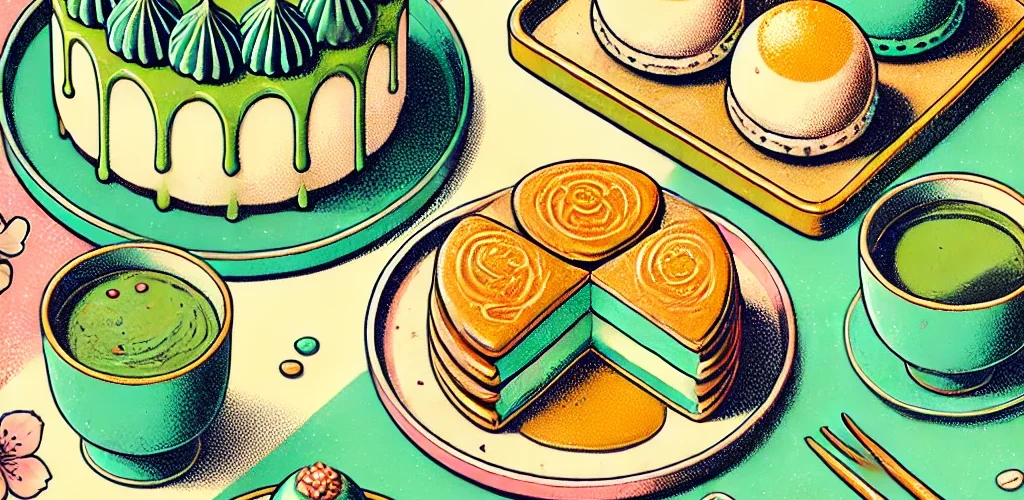From matcha tiramisu to fluffy Japanese soufflé pancakes and chewy mochi in every imaginable flavor, Asian desserts are enjoying their moment in the global spotlight. Once considered niche, these sweets are now trending across cafés, TikTok feeds, and patisserie menus worldwide. Their appeal lies in their ability to surprise: lighter textures, less sugar, and unexpected ingredients like sesame, yuzu, or red bean challenge Western dessert norms.
This trend isn’t just about taste—it’s about aesthetics, culture, and identity. Social media amplifies the visual magic of pastel-hued jellies, bunny-shaped mochi, and cube-shaped cheesecakes. At the same time, consumers are more curious than ever, craving cultural mashups and authenticity in equal measure. What began as novelty has grown into a cultural wave, reshaping how desserts are defined and consumed.
Trend Snapshot
| Aspect | Details |
|---|---|
| Trend Name | Asian Desserts – sweet creations from East and Southeast Asia gaining global traction |
| Key Components | Matcha, mochi, red bean paste, black sesame, tapioca pearls, condensed milk, coconut, glutinous rice |
| Spread | Global – trendy cafés in New York, London, Berlin, Tokyo; TikTok and Instagram; pop-up dessert bars |
| Examples | Keki Modern Cakes (NYC), Café Kitsuné, Tiger Sugar, Kyo Matcha, Uncle Tetsu’s Cheesecake |
| Social Media | #AsianDesserts, #MochiMadness, #MatchaLover, #BingsuSeason, #KawaiiTreats |
| Demographics | Gen Z and Millennials, especially foodies and social media natives |
| Wow Factor | Visually stunning, lighter sweetness, unique textures, cultural storytelling |
| Trend Phase | Peak – with strong potential for evolution and hybrid innovation |
Fluffy, Chewy, Creamy: Texture Is the Star
Asian desserts stand out for their obsession with texture, which extends far beyond the classic Western contrast of crisp and creamy. Chewiness defines some of the most beloved treats, from mochi to bubble tea pearls to tangyuan (sticky rice balls). These desserts offer a sensory satisfaction that’s both playful and comforting. On the opposite end of the spectrum, cloudlike textures dominate—soufflé pancakes and Japanese cheesecakes practically dissolve on the tongue, creating a gentle indulgence that feels light yet decadent.
Texture here isn’t an afterthought; it’s the hook. Many Asian desserts layer multiple consistencies—jelly, foam, custard, syrup—in ways that surprise the palate without overwhelming it. This layered experience plays perfectly into ASMR-driven food culture, where the tactile and the audible are as important as the flavor itself. Mainstream brands have noticed: mochi ice cream is now a freezer-aisle staple in global supermarkets, and Starbucks has tested red bean and matcha-inspired drinks across select markets. Texture has become part of the storytelling, drawing consumers into experiences that feel fresh, tactile, and addictive.
The East Meets West Remix Culture
What propels Asian desserts beyond adoption is remix culture. These sweets are not only being embraced—they’re being reinvented. Hybrid creations like matcha tiramisu, mochi donuts, and ube mille-feuilles combine global pastry techniques with Asian flavors. The result: desserts engineered for virality, blending tradition with novelty.
According to Eater, mochi donuts exemplify this crossover—marrying the chew of glutinous rice flour with the glazed appeal of American-style donuts. Similar mashups include Thai tea crepe cakes, black sesame Swiss rolls, and halo-halo reimagined with modern patisserie flair. These innovations appeal to Gen Z, who thrive on cultural fusion and personalization.
Platforms like TikTok and Instagram accelerate the trend by making each dessert both content and consumption. Behind-the-scenes baking videos, ASMR bite tests, and quick recipe hacks allow audiences to experience these desserts digitally before ever tasting them. In this sense, Asian sweets aren’t just foods—they’re media products optimized for engagement.
Too Pretty to Eat and Perfect to Post
The visual appeal of Asian desserts is a key driver of their popularity. Pastel palettes, delicate forms, and playful designs dominate the genre. Think sakura blossom jellies, bunny-shaped mochi, or cube-shaped cheesecakes. These treats are designed to be photographed before they’re eaten, which makes them ideal for a generation that consumes with the eyes as much as the palate.
BBC Good Food notes that visual storytelling is central to the appeal, embedding cultural origins and seasonal inspirations into the design of each dessert. A Vietnamese flan served in a coconut or a Japanese parfait swirled with matcha isn’t just pretty—it’s a story about place, heritage, and creativity.
This aesthetic power makes Asian desserts an effective brand-building tool. Restaurants and cafés can leverage their visual appeal to draw in consumers, while influencers amplify their reach through highly shareable content. For Gen Z and Millennials, authenticity isn’t only about ingredients—it’s about presentation that reflects creativity and cultural respect.
Bigger Than a Trend: A Cultural Movement
Asian desserts are no longer niche; they’re part of a larger cultural shift. Their rise reflects growing respect for Asian cuisines as sophisticated and diverse, rather than simply “exotic.” More Asian-owned businesses and chefs are getting the global spotlight, using desserts as a medium to express heritage while innovating for new audiences.
The South China Morning Post highlights how desserts like halo-halo, bingsu, and mochi have become global ambassadors of Asian culinary identity. Beyond sweet indulgence, these foods symbolize cultural pride, inclusivity, and cross-cultural appreciation.
Looking ahead, Asian desserts are set to move further into mainstream dining. Expect them to appear not just in dessert cafés but also in brunch menus, beverage lines, and snack boxes. From mochi-filled croissants in Paris to ube lattes in Los Angeles, these creations embody global fusion at its sweetest. For consumers, they’re more than desserts—they’re cultural experiences wrapped in pastel colors and chewy textures.
If Asian desserts bring sweetness to everyday life, the next frontier is even more radical: lab-grown gourmet, where science reinvents luxury itself. Explore the future of indulgence here.

